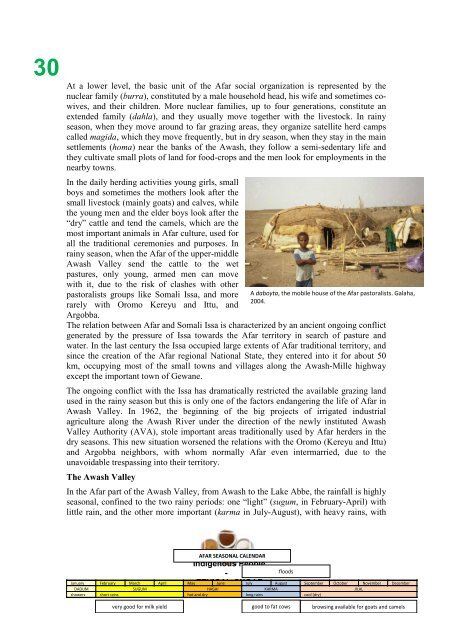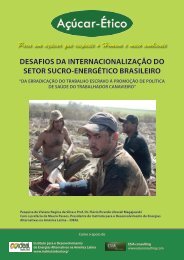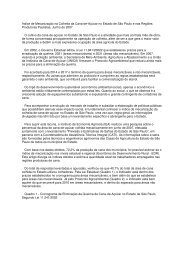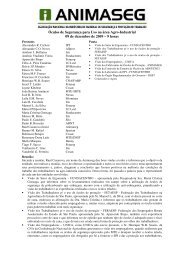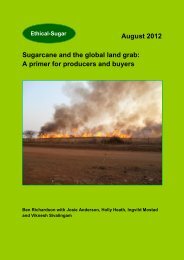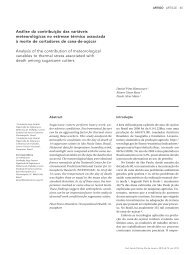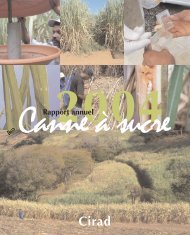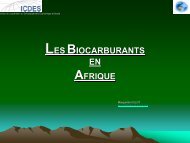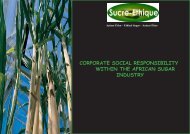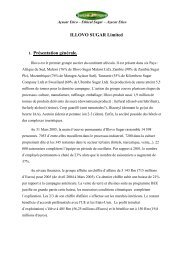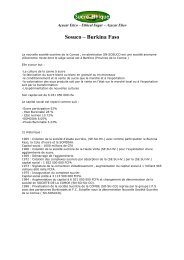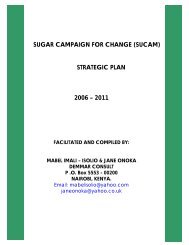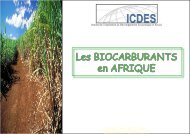Sugar Cane And Indigenous People - Sucre Ethique
Sugar Cane And Indigenous People - Sucre Ethique
Sugar Cane And Indigenous People - Sucre Ethique
Create successful ePaper yourself
Turn your PDF publications into a flip-book with our unique Google optimized e-Paper software.
30At a lower level, the basic unit of the Afar social organization is represented by thenuclear family (burra), constituted by a male household head, his wife and sometimes cowives,and their children. More nuclear families, up to four generations, constitute anextended family (dahla), and they usually move together with the livestock. In rainyseason, when they move around to far grazing areas, they organize satellite herd campscalled magida, which they move frequently, but in dry season, when they stay in the mainsettlements (homa) near the banks of the Awash, they follow a semi-sedentary life andthey cultivate small plots of land for food-crops and the men look for employments in thenearby towns.In the daily herding activities young girls, smallboys and sometimes the mothers look after thesmall livestock (mainly goats) and calves, whilethe young men and the elder boys look after the“dry” cattle and tend the camels, which are themost important animals in Afar culture, used forall the traditional ceremonies and purposes. Inrainy season, when the Afar of the upper-middleAwash Valley send the cattle to the wetpastures, only young, armed men can movewith it, due to the risk of clashes with otherpastoralists groups like Somali Issa, and morerarely with Oromo Kereyu and Ittu, andArgobba.The relation between Afar and Somali Issa is characterized by an ancient ongoing conflictgenerated by the pressure of Issa towards the Afar territory in search of pasture andwater. In the last century the Issa occupied large extents of Afar traditional territory, andsince the creation of the Afar regional National State, they entered into it for about 50km, occupying most of the small towns and villages along the Awash-Mille highwayexcept the important town of Gewane.The ongoing conflict with the Issa has dramatically restricted the available grazing landused in the rainy season but this is only one of the factors endangering the life of Afar inAwash Valley. In 1962, the beginning of the big projects of irrigated industrialagriculture along the Awash River under the direction of the newly instituted AwashValley Authority (AVA), stole important areas traditionally used by Afar herders in thedry seasons. This new situation worsened the relations with the Oromo (Kereyu and Ittu)and Argobba neighbors, with whom normally Afar even intermarried, due to theunavoidable trespassing into their territory.The Awash ValleyA daboyta, the mobile house of the Afar pastoralists. Galaha,2004.In the Afar part of the Awash Valley, from Awash to the Lake Abbe, the rainfall is highlyseasonal, confined to the two rainy periods: one “light” (sugum, in February-April) withlittle rain, and the other more important (karma in July-August), with heavy rains, withEthiclAFAR SEASONAL CALENDAR<strong>Indigenous</strong> <strong>People</strong>-ETHICAL-SUGARJanuary February March April May June July August September October November DecemberDADUM SUGUM HAGAI KARMA JILALshowers short rains hot and dry long rains cool (dry)floodsvery good for milk yieldgood to fat cowsbrowsing available for goats and camels


